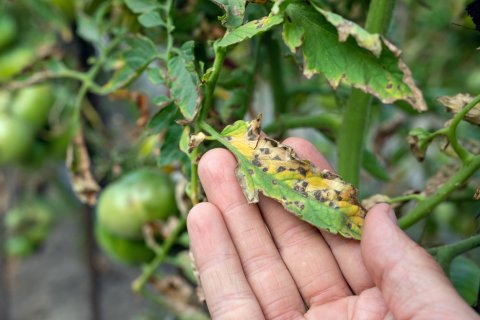Plant pathogen evades immune system by targeting the microbiome
Secreted molecules help a fungal plant pathogen to avoid eradication
A fungus responsible for crop losses appears to evade the plant’s immune system by targeting its microbiome. An international team of biologists discovered that the plant pathogen Verticillium dahliae uses secreted molecules to target the microbiome and promote infection. Their results may lead to new approaches to curtail the fungus and protect crops.

Biologists have discovered how a pathogenic fungus bypasses the immune system of plants to avoid eradication. The fungus Verticillium dahliae, which causes wilt disease in many crop species, secretes molecules that specifically target the plant’s microbiome. This way, the fungus avoids being eliminated by microbial competitors that are beneficial to the plant.
The research was performed by the team of Bart Thomma at the University of Cologne, together with the team of Michael Seidl at Utrecht University. They published their results in the journal Proceedings of the National Academy of Sciences.
Recruiting microbes
Scientists increasingly recognize that the well-being of an organism is dependent on the bacteria and other microbes that are living in and on the organism. The totality of all these microbes is called the microbiome. For example, in humans as well as other animals, specific microbes inhabiting the gut and the skin have beneficial effects.
This is similarly true for plants. Moreover, it has been shown that plants can ‘recruit’ beneficial microbes from their environment, for instance from the soil surrounding the roots, to help them withstand disease.
Fungus disturbs microbiome upgrades
Thomma’s and Seidl’s research teams hypothesized that some pathogens have evolved tricks to perturb a host’s ‘cry for help’ by disturbing the plant microbiome. Thus, in addition to the direct suppression of the plant host’s immune responses, these pathogens can suppress immunity indirectly by affecting the plant’s healthy microbiome.
The study shows that the fungus secretes the antimicrobial proteins to manipulate the plant’s microbiome.
The researchers focused on Verticillium dahliae, a well-known pathogen of many plants, including greenhouse crops like tomatoes and lettuce, but also olive trees, ornamental trees and flowers, cotton, and potatoes. Their study shows that the fungus secretes the antimicrobial protein VdAMP3 to manipulate the plant’s microbiome as a so-called effector.
Fungus disturbs microbiome
Generally, effector molecules target components of the host immune system, leading to immune suppression. The authors have now shown that these targets extend to inhabitants of the host’s microbiome. During host colonization, the VdAMP3 molecule suppresses beneficial organisms in the microbiome of the plant. This leads to microbiome disturbance, or ‘dysbiosis’. This enables the fungus to complete its life cycle and produce progeny that can spread and start new infections.
Targeting competing fungi
“In terms of evolution, the molecule that is secreted is very old”, said Thomma, noting that similar molecules also occur in organisms that are not pathogenic on plants. “It looks like Verticillium uses the molecule to ‘exploit’ it during the process of disease development on the host. Interestingly, the molecule does not act like a broad-spectrum antibiotic that targets any microbe, but specifically against competing fungi species that have abilities to hinder Verticillium dahliae.”
Potential candidates
Initially, the researchers wanted to find out whether Verticillium dahliae had effectors in its arsenal that have antimicrobial activity. Different candidates were tested for their ability to inhibit the growth of microbes in the laboratory. VdAMP3 was one of these potential candidates. Follow-up experiments then showed that without this effector, other fungi could thrive and suppress the formation of reproduction structures of Verticillium dahliae.
VdAMP3 is active in later stages of disease development when Verticillium dahliae needs to produce these new reproduction structures to start infections of new hosts. However, this is not the first molecule the scientists have identified. A year ago, they found a molecule that does not act against competing fungi, like VdAMP3, but against bacterial competitors.
Consider the entire microbiome
“These findings demonstrate that pathogens use various molecules at various stages of the disease process to manipulate the healthy microbiome of a host to cause disease”, said Thomma. “This shows that it is important to look beyond just the interaction between a pathogen and a host, if we want to understand disease.” According to Thomma, researchers should take the entire microbiome of the host into account as well. A better approach would be to regard the host as an ecological unit formed by the host and all the organisms living in and on it.
A better understanding of these mechanisms may help to develop more resilient plants and better strategies for crop protection.
Developing more resilient plants
A better understanding of these mechanisms may help to develop more resilient plants and better strategies for crop protection. In the face of a growing world population, limited farmland, and the need to reduce environmental impact and pollution, one of the major aims of plant scientists is to increase the yield of field crops while minimizing our ecological footprint on the environment. “Learning more about these effector molecules that help pathogenic fungi infect crop plants may lead to new ways to protect them against pathogens,” said biologist Nick Snelders, who is affiliated with both Utrecht University and the University of Cologne.
Novel antibiotics
In future studies, the authors aim to find further effector proteins with selective antimicrobial activity – from Verticillium dahliae, but also from other pathogens that have other infection strategies. Snelders concludes: “Unravelling how these molecules work, and how they can inhibit one microbe while not affecting the other, is important to discover novel mechanisms to target microbes. This may ultimately even lead to the development of novel antibiotics.”
Publication
Proceedings of the National Academy of Science. doi: 10.1073/pnas.2110968118
Nick C. Snelders*, Gabriella C. Petti, Grardy C. M. van den Berg , Michael F. Seidl*, Bart P. H. J. Thomma
* = Researchers affiliated with Utrecht University

